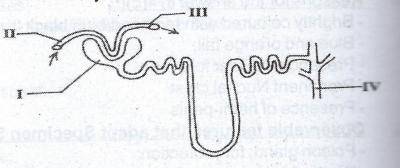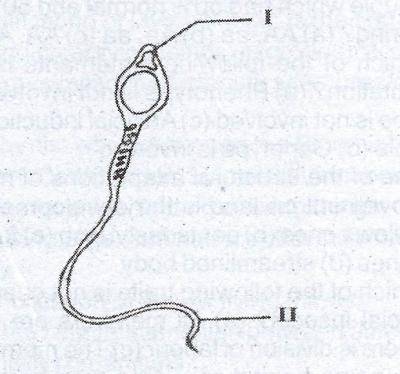Year :
2017
Title :
Biology
Exam :
WASSCE/WAEC MAY/JUNE
Paper 1 | Objectives
11 - 20 of 49 Questions
| # | Question | Ans |
|---|---|---|
| 11. |
Which of the following actions does not occur during exhalation in man? A. Thoracic cavity decreases in volume B. Diaphragm flattens C. Ribs move down and in D. Air pressure increases in the thoracic cavity Detailed SolutionWhen you breathe in, or inhale, your diaphragm tightens and moves downward (flattens). |
|
| 12. |
 The diagram above is an illustration of the urinary tubule in a mammal. Which of the following substances is found in the part labelled II only? A. Lipid B. Glucose C. Urea D. Uric acid |
C |
| 13. |
 The diagram above is an illustration of the urinary tubule in a mammal. The part which contains lowest concentration of urea is labelled A. I B. II C. III D. IV |
C |
| 14. |
 The diagram above is an illustration of the urinary tubule in a mammal. Which of the following substances is greater in concentration in the part labelled IV when compared to that part labelled I? A. Lipid B. Glucose C. Urea D. Uric acid |
C |
| 15. |
Deamination of amino acids in the liver produces A. blood sugar B. glycogen C. bile D. urea |
D |
| 16. |
Which of the following glands also serves as an exocrine gland? A. Ovary B. Pancreas C. Adrenal D. Thyroid Detailed SolutionThe liver and pancreas are both exocrine and endocrine glands; they are exocrine glands because they secrete products—bile and pancreatic juice—into the gastrointestinal tract through a series of ducts, and endocrine because they secrete other substances directly into the bloodstream. |
|
| 17. |
Which of the following sequences is the correct route of the transmission of impulses along a reflex arc? A. \(Receptor\to sensory neuron \to synapse \to intermediate neuron \to synapse \to motor neuron \to effector\) B. \(Receptor \to motor neuron \to synapse \to intermediate neuron \to synapse \to sensory neuron \to effector\) C. \(Effector \to intermediate neuron \to synapse \to motor neuron \to synapse \to sensory neuron \to receptor\) D. \(Effector \to motor neuron \to synapse \to sensory neuron \to synapse \to intermediate neuron \to receptor\) |
A |
| 18. |
When viewing an object that is close to the human eye, the A. eye lens becomes thin B. ciliary muscles relax C. suspensory lens become taut D. eye lens becomes fat |
D |
| 19. |
 The diagram above is an illustration of the human sperm. The part labelled I is the A. acrosome B. nucleus C. mitochondrion D. tail |
A |
| 20. |
 In the diagram of the human sperm above, the function of the part labelled II is to A. fuse the ovum during fertilization B. generate the energy for the sperm to swim to the fallopian tube C. help the sperm to swim forward D. dissolve the membrane of the egg during fertilization |
C |
| 11. |
Which of the following actions does not occur during exhalation in man? A. Thoracic cavity decreases in volume B. Diaphragm flattens C. Ribs move down and in D. Air pressure increases in the thoracic cavity Detailed SolutionWhen you breathe in, or inhale, your diaphragm tightens and moves downward (flattens). |
|
| 12. |
 The diagram above is an illustration of the urinary tubule in a mammal. Which of the following substances is found in the part labelled II only? A. Lipid B. Glucose C. Urea D. Uric acid |
C |
| 13. |
 The diagram above is an illustration of the urinary tubule in a mammal. The part which contains lowest concentration of urea is labelled A. I B. II C. III D. IV |
C |
| 14. |
 The diagram above is an illustration of the urinary tubule in a mammal. Which of the following substances is greater in concentration in the part labelled IV when compared to that part labelled I? A. Lipid B. Glucose C. Urea D. Uric acid |
C |
| 15. |
Deamination of amino acids in the liver produces A. blood sugar B. glycogen C. bile D. urea |
D |
| 16. |
Which of the following glands also serves as an exocrine gland? A. Ovary B. Pancreas C. Adrenal D. Thyroid Detailed SolutionThe liver and pancreas are both exocrine and endocrine glands; they are exocrine glands because they secrete products—bile and pancreatic juice—into the gastrointestinal tract through a series of ducts, and endocrine because they secrete other substances directly into the bloodstream. |
|
| 17. |
Which of the following sequences is the correct route of the transmission of impulses along a reflex arc? A. \(Receptor\to sensory neuron \to synapse \to intermediate neuron \to synapse \to motor neuron \to effector\) B. \(Receptor \to motor neuron \to synapse \to intermediate neuron \to synapse \to sensory neuron \to effector\) C. \(Effector \to intermediate neuron \to synapse \to motor neuron \to synapse \to sensory neuron \to receptor\) D. \(Effector \to motor neuron \to synapse \to sensory neuron \to synapse \to intermediate neuron \to receptor\) |
A |
| 18. |
When viewing an object that is close to the human eye, the A. eye lens becomes thin B. ciliary muscles relax C. suspensory lens become taut D. eye lens becomes fat |
D |
| 19. |
 The diagram above is an illustration of the human sperm. The part labelled I is the A. acrosome B. nucleus C. mitochondrion D. tail |
A |
| 20. |
 In the diagram of the human sperm above, the function of the part labelled II is to A. fuse the ovum during fertilization B. generate the energy for the sperm to swim to the fallopian tube C. help the sperm to swim forward D. dissolve the membrane of the egg during fertilization |
C |